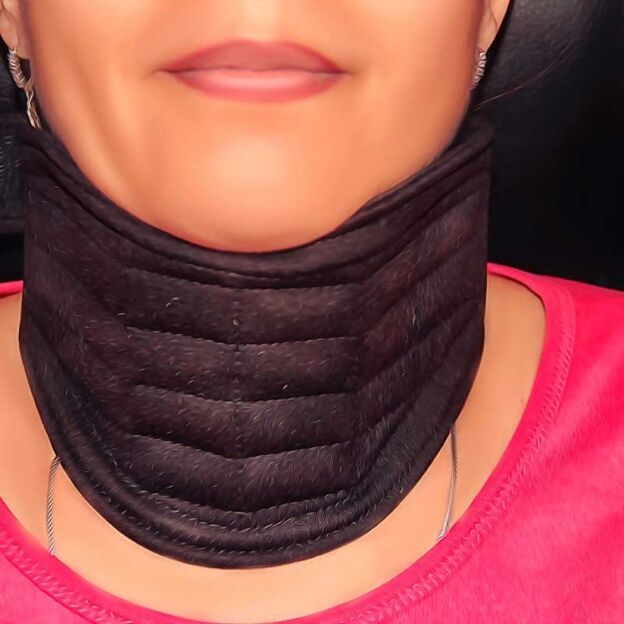Osteochondrosis of the cervical spine is asymptomatic as long as the intervertebral discs cope with their amortization duties. As soon as its thickness begins to decrease, instability occurs. The body compensates for it with the growth of osteophytes, as a result, a person feels a stiff neck, and over time other unpleasant symptoms appear, significantly worsening the quality of life. Treatment of osteochondrosis of the cervical spine should be comprehensive.

This means that drug therapy alone (injections, tablets, ointments) is not enough. In addition to her, it is imperative to do special therapeutic exercises, massage, take courses of hirudotherapy (treatment with leeches), and also do elementary exercises at home. As a complement to the main treatment, the use of folk remedies is allowed.
Medicines
The doctor's priority is to relieve the patient's pain. For these purposes, a whole complex of drugs is used:
- nonsteroidal anti-inflammatory;
- anesthetics and hormones (for blockages);
- muscle relaxants;
- chondroprotectors;
- sedatives and antidepressants;
- Vitamins B.
The groups of drugs listed in the complex play the role of a powerful anesthetic complex for osteochondrosis, and also nourish the intervertebral discs and restore nerves:
- NSAIDs relieve mild to severe pain and inflammation.
- Anesthetics and hormonal agents are injected into the pain site (paravertebral or vagosympathetic); pain syndrome stops instantly. The patient is then placed in a collar for a time so that he cannot jerk his head.
- Muscle relaxants are used to relax spasmodic muscles.
- Chondroprotectors improve the nutrition of the intervertebral discs. Its reception begins at the same time as NSAIDs. In general, the use of chondroprotectants is long-term and complex. This means that the doctor can prescribe, along with external agents, oral medications, as well as injections.
- Sedatives and antidepressants help the patient cope with stress, prevent depression, which in turn helps cope with muscle tension.
- Complex preparations of vitamin B. Lack of B1, 6 and 12 negatively affects nerve fibers and neuronal conduction. First, the drugs are prescribed in the form of injections in a short course, then they switch to supportive therapy and take pills.
On a note. Most NSAIDs and chondroprotectors come in various forms: tablets, ointments, injections, as well as rectal suppositories (NSAIDs) and patches (NSAIDs).
Therapeutic gymnastics and massages
As soon as the pain syndrome disappears, it is necessary to gradually increase the motor activity of the cervical spine. If the patient had a blockage, the bandage is removed after about a week.

Some doctors believe that it is always necessary to move. When the patient is prescribed bed rest, it is believed that this helps to cope with the disease, but in fact the person gets the opposite effect: on one side of the neck, the spasmodic muscles, if muscle relaxants were not used, remain Constrained, on the other hand, on the other hand, its slow weakening (sagging or loss of tone) is observed. As a result, returning to a working rhythm, a patient with cervical osteochondrosis in a fairly short time will inevitably again face pain, limited mobility and muscle spasms. If you dedicate yourself to physical education dosed and little by little, but constantly, you can achieve pain relief with minimal use of painkillers.
Physiotherapy doctors and chiropractors share the same point of view. His techniques are based on movement, not on the bed, as advocated by 90% of doctors trying to relieve a patient with cervical osteochondrosis from pain.
Exercises for acute pain.
This is static gymnastics, in which the cervical spine does not perform any movement. Physiotherapy doctor recommends doing the following 3 exercises for headaches, tinnitus, neck pain:
- Sit on a chair, straighten your back, look straight. Place your hands on top of each other and place them under your chin. Begin to press your chin into your hands, as if you wanted to lower your head. At this time, the spine is not involved in any way, but the muscles in the front of the neck are tight. Press your hands for 3 to 5 seconds, then lower your arms and relax. Repeat several times.
- Continue to sit up straight and look straight ahead. Place the back of your right hand on your cheek. Begin to turn your head to the right, while resisting with your hand. The head is immobile. Press for 3 to 5 seconds, then remove your hand and relax. Repeat several times. Repeat exercise n. 2 with the other hand.
- Place the brushes on top of each other at the back of your head. Imagine throwing your head back. Resist with your hands. At the moment of pressure, wait 3 to 5 seconds. Then lower your arms and relax. Repeat several times.
You don't need to press your hands with all your might. This will backfire - the pain will intensify. All movements are as smooth as possible, slow, without jerks. The number of approaches per day is 2-3 times.
On a note. Static exercises are similar to micromotion techniques. As a result, the muscles relax, the pain gradually disappears.
A universal set of exercises for cervical osteochondrosis.
Gymnastics can be performed independently, at home, both during remission and at the time of exacerbation.
The universal complex consists of 6 exercises:
- Stand straight, feet shoulder-width apart, expand your chest. Put your hands on your shoulders. Perform symmetrical circular motions backward (at least 10 times), then forward (10 times). The body and neck are immobile. After finishing the exercise, lower your arms down and shake your shoulders, relax.
- Please continue standing. Extend your arms to the sides parallel to the floor, clench your fists. Now imagine swinging dumbbells. At the same time, bend your elbows and touch your shoulders with your fists, then stretch them out. Repeat 10-15 times. After finishing the exercise, shake your hands from your shoulders and relax.
- Stay in the starting position. The exercise is static. Interlock your fingers and place your palms on your forehead. Begin, as it were, to lower your head forward. Resist with your hands. Hold the pressure position for 3-5 seconds, then relax. They work the muscles in the back of the neck.
- Perform exercise number 3 of the complex with exacerbation of cervical osteochondrosis.
- From the starting position, without moving your neck, bring your shoulders forward, hold for 3-5 seconds, then straighten and bring your shoulder blades together and relax. Repeat several times.
- From the starting position: breathe deeply with your nose - raise your arms to the sides and up, lower in front of you - exhale completely through your mouth. In an acute period, raise your arms down, parallel to the floor.
On a note. For a complete cure of the cervix.osteochondrosisthese exercises are not enough. However, they are suitable for relieving acute pain and restoring mobility of the spine.
Micromotion
A chiropractor has developed a system to help patients with cervical osteochondrosis:
- Sit in a chair and lean back. Now imagine that you agree with someone - shake your head slightly. You can do this for as long as you want, until you get bored. As soon as they were given a free minute, they sat down and did it. Free refills.
- The starting position is exactly the same as in exercise 1. Only now you disagree with the interlocutor: move your head to the left and to the right just perceptibly. Do it for as long as is convenient. Free refills.
On a note. The sets of exercises can be combined with each other. This will give a noticeable effect in a short time: the pain will disappear.
Massage
It is better to entrust the massage of the cervical spine to a specialist. However, in case of severe pain, if it is possible to lift and put your hands behind your head without pain, you can try to help yourself. There are many self-massage techniques.
The simplest self-massage is performed as follows:
- Sit in a chair. Raise up and place your hand behind your head on the side opposite the pain.
- Begin stroking her neck in the area of inflammation. Do it gently at first, with almost no pressure. Then slightly increase the intensity.
- It goes down to the shoulder. As a general rule, when the torticollis reaches, it hurts not only the neck on one side, but also the shoulder. Stretch your shoulder. This should be done actively so that the spasmodic muscles warm up, but there should be no severe pain from self-massage.
- Repeat this process on the other side of the neck. This must be done because, on the one hand, the muscles are spasmodic and, on the other, they are relaxed; you need to level your tone.
- Put both hands behind the head and place the fingers along the spine (along the spinous processes). Work carefully, but actively enough, in this area. Do not apply excessive pressure. The neck is the most delicate part of the spine. An awkward movement can hurt you and make the situation worse.
- Apply any anesthetic gel or ointment you have in your medicine cabinet to the warmed cervical spine.
Do not use hot ointments for self-massage. The skin on the neck is very delicate, especially in the area of the arteries and in the forehead. If the heating compound gets there, it can burn.
Hirudotherapy
Leech treatment for osteochondrosis, especially of the cervical spine, is very effective. Hirudotherapy helps to:
- reduces pain;
- improve blood circulation in the area of influence of leeches - arterial blood flow to the brain and venous blood outflow are normalized;
- relieve swelling
- enhance the effect of drugs;
- improve sleep;
- relieve psychological stress;
- Significantly reduce headaches and dizziness.
Not everyone is allowed this type of treatment. Be sure to undergo a comprehensive examination before leeching treatment. If there are no contraindications, 7-10 procedures are performed. To consolidate the result in a month, you can go to a hirudotherapist again.
Home remedies
Try the following recipes:
- rub the nape of the neck with an Indian onion leaf, cover it with something warm on top and go to bed;
- self-massage with honey: rub the neck and shoulder girdle with honey, then apply a towel soaked in warm water, after 10 minutes remove the remnants of honey (if any) and go to bed, covered with a blanket;
- take a steam bath, but not during exacerbations, then massage with honey and drink herbal tea;
- use a needle applicator: put the plate with needles in the area of the 7th cervical vertebra, if the sensations are tolerable, sleep on the needles; in the morning you will notice significant relief.

There are many ways to treat cervical osteochondrosis. In addition to those described, an effective therapy method is acupuncture, yoga, Pilates, and fitball exercises. Remember, self-medication is dangerous. Make an appointment with your doctor and get a full checkup. The specialist will individually select the treatment and tell you which exercises can and cannot be done, whether self-massage is possible, whether leeches will help, or perhaps he will recommend one of the methods of alternative medicine, for example, bee sting.



















































